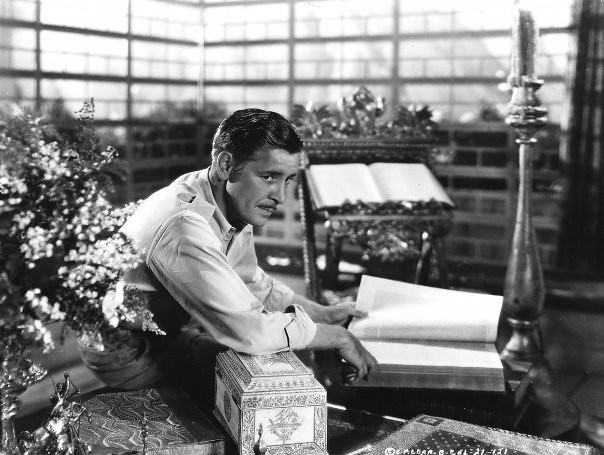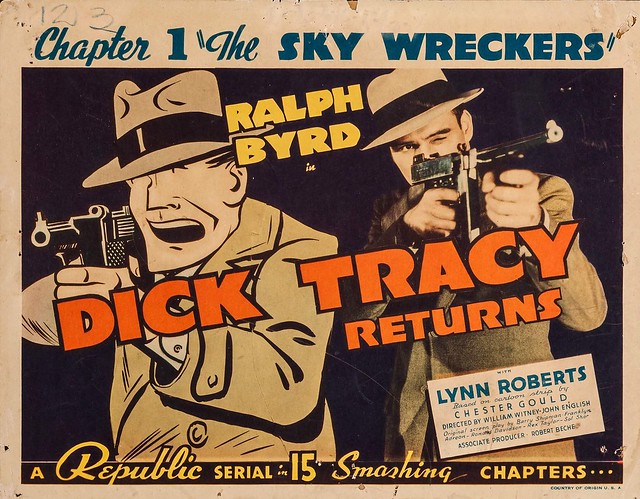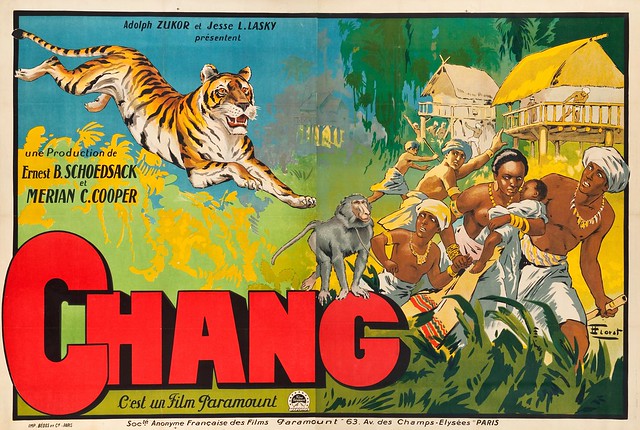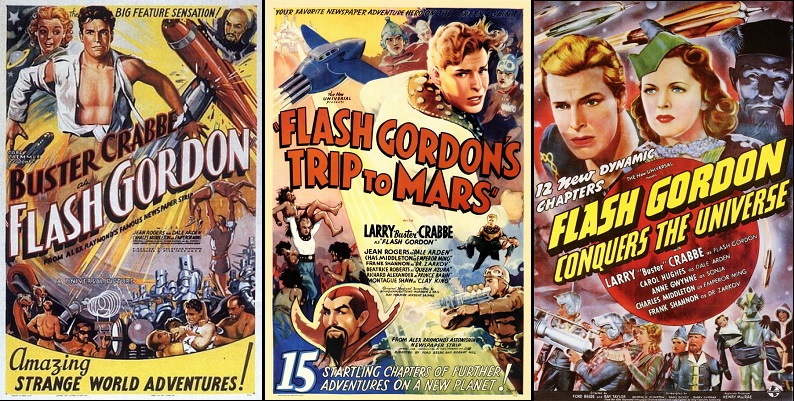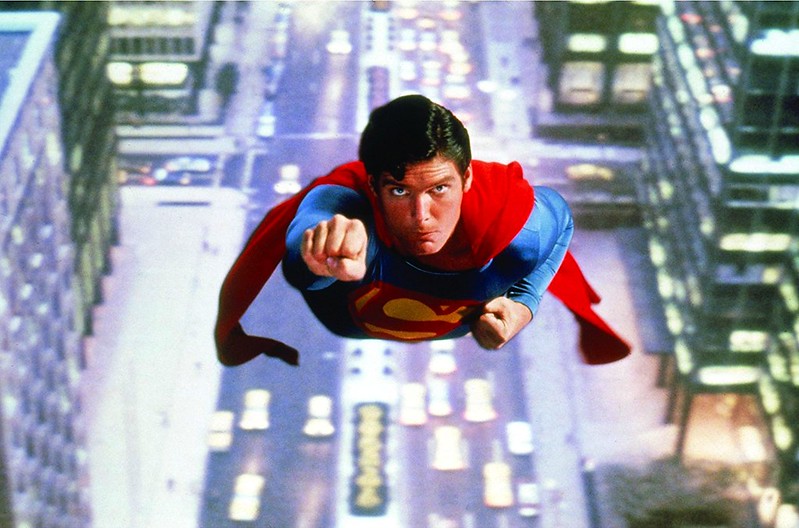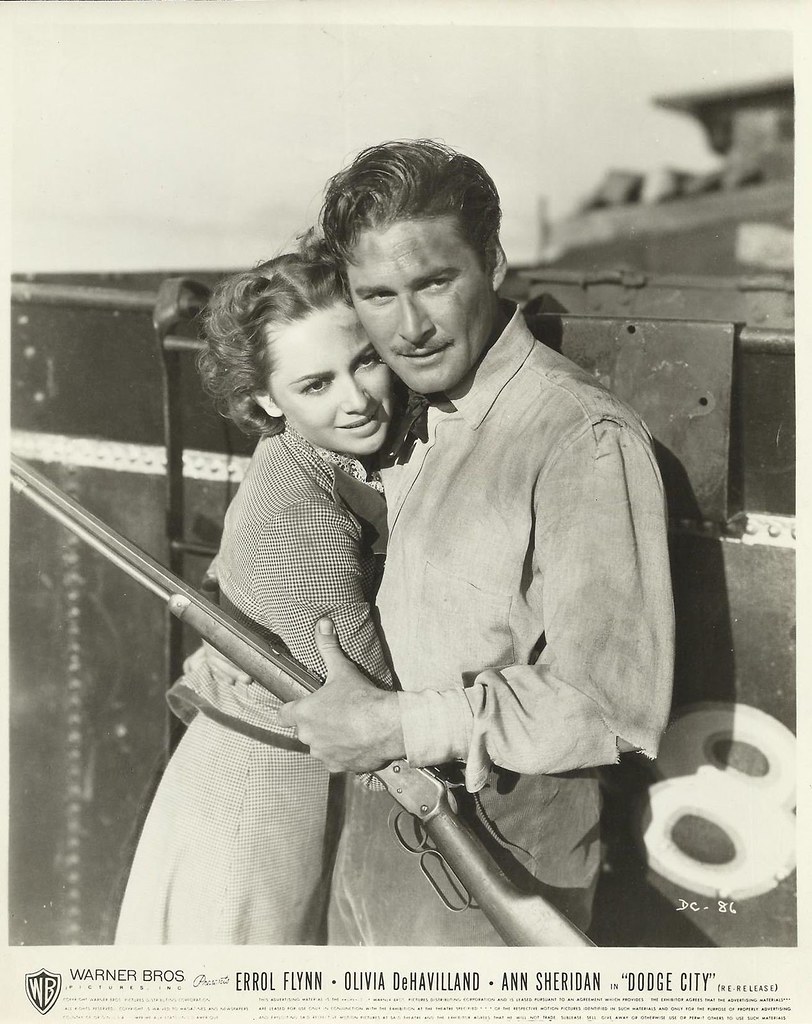The following movie groups I created on Facebook. Whether it’s down the river of Egypt or through the valley of Republic, under the shadows of Noir, or in the light of faith, we explore and rediscover areas of film history that are off the beaten path. Despite the number of groups, every subject is given the attention it deserves; all the sites have extensive photo archives. (The newer groups, in most instances, benefit from organized albums.)
Below, I give a short description of the group and why film buffs are encouraged to join the community. The year in parentheses indicates when the group was created. Clicking on the title will take you directly to Facebook.
Updated November 2022
~MCH
The Original Six:
The Ronald Colman Appreciation Society (2008): A social media extension of founder George Schatz’s Ronald Colman Appreciation Society, the RCAS is the largest group on Facebook dedicated to my favorite actor, Ronald Colman (1891-1958). If you are a fan of such films as Lost Horizon (1937), The Prisoner of Zenda (1937), or Random Harvest (1942), this society will be your Shangri-La. It currently has over 2,100 members and several moderators. The RCAS is very active in promoting the legacy of RC and led the campaign to get Lost Horizon included on the Library of Congress’ National Film Registry.
Frances Drake (2008): Originally conceived as a private group to store my own stills of actress Frances Drake (1912-2000), I made it public to all her admirers. The star of Mad Love (1935) and The Invisible Ray (1936) is relatively forgotten in the 21st century, but there are still some who remember and love her. In addition to her great beauty, Frances had the kind of class that is almost non-existent today. Although my obsession doesn’t quite rival Peter Lorre’s in Mad Love— I don’t have a wax replica of her yet– I hope my efforts, particularly with the photos, keep her memory alive to some small degree.
Film Noir (2009): Up until 2018, this had been the largest classic film noir group on Facebook. Now with nearly 32,000 members, it remains the oldest and has the largest photo gallery anywhere. It’s also the largest noir group maintained by only one person. Posts are kept mainly to the classic period– from 1940 to 1958. The group was created as a result of the 2009 Film Noir program at the Park Ridge Public Library– my first classic film program for the library.
Screen Deco (2009): Showcasing Art Deco in Hollywood set design, Screen Deco has become one of the more popular groups– over 3,000 members– thanks to gorgeous images detailing architecture and fashion in Hollywood films from the 1920s and 1930s. The group is based on the book Screen Deco, which later inspired my 2012 film series at the Park Ridge Public Library. (My friend Laura Wagner is a co-administrator.)
The Fredric March Film Society (2009): A group dedicated to Fredric March (1897-1975)– the finest actor of his generation. Like a great craftsman, March disappeared into his roles and never became the kind of star that Cary Grant or Humphrey Bogart were; they usually played themselves onscreen. Regardless, few dramatic actors had March’s range, ability, and intensity. He was a success both in film and on stage. For those unfamiliar with his work, he won Academy Awards for Best Actor in Dr. Jekyll & Mr. Hyde (1932) and The Best Years of Our Lives (1946). My trip to March’s hometown in Racine, Wisconsin, in 2009 was the first of my visits to various actors’ hometowns.
Buster Keaton, Harold Lloyd, and Charlie Chaplin: Legends of Laughter (2010): Another group created to promote a Park Ridge Public Library film program. We focus exclusively on the three great “silent clowns”: Buster Keaton (1895-1966), Harold Lloyd (1893-1971), and Charlie Chaplin (1889-1977). There are always new discoveries to be made and shared, particularly by noteworthy authors who have contributed. Every post helps members appreciate the rare genius of each performer. This is my second-largest group with over 5,000 members.
The Newer Groups:
Col. Tim McCoy’s Real Wild West (2017): If you’ve never heard of Tim McCoy (1891-1978), I suggest you find a copy of Tim McCoy Remembers the West as a proper introduction. For my money, McCoy was the greatest of the B-Western cowboys. He had his own unique style. He was, in fact, the first cowboy star MGM employed in the silent era. Col. Tim was a fascinating man off the screen with his military record, his work on behalf of Native Americans, and his colorful career in the circus. If you think John Wayne was the greatest cowboy hero, keep in mind McCoy was a real cowboy– one who served his country in two World Wars.
Films of Faith (2018): Inspired by my 2015 film program, Cinema of Transcendence, this group examines the role of religion in classic film– from the silents of the 1920s to the great biblical epics of the 1950s and 1960s. In an increasingly secular society, this topic is becoming less popular, at least in the film community, but to those who are genuinely interested in how motion pictures can be used to convey God’s message, Films of Faith is for you– and needs you.
Allure: Screen Glamour in the Golden Age (2018): What I call a “sister group” of Screen Deco, Allure focuses solely on the glamour aspect of classic Hollywood. Emphasis is on the beautiful portrait photography from the 1920s through the 1940s. Actresses like Myrna Loy, Joan Crawford, and Carole Lombard have a considerable presence. They had allure. See who else had it!
Warning Shadows: German Expressionist Cinema (2018): This niche group– with over 4,000 members– highlights the role of German Expressionism in world cinema. Films like The Cabinet of Dr. Caligari (1919) and Nosferatu (1922) are studied, among others. Fans of Film Noir would be particularly interested in this early precursor to the noir style.
Ancient Egypt in Classic Film (2018): Inspired by the 1932 film The Mummy, this “scripts & scrolls” group explores how Egypt has been depicted and caricatured on film– in features, B movies, shorts, cartoons, and newsreels. If you are fascinated at all by the history– and mystery– of ancient Egypt, you will enjoy this romantic trip down the Nile.
Valley of the Cliffhangers: The Republic Serials (2018): One of the most fun and fastest-growing groups on Facebook– now with 1,200 members! For those who remember the movie serials of the 1930s, ’40s, and ’50s, this group celebrates the best of the American chapterplay. Republic Pictures made the finest serials, and our community is the only one dedicated exclusively to Republic. Many knowledgeable fans and enthusiasts have already joined and contributed greatly to its early success.
Fay Wray: The Girl in the Hairy Paw (2019): In memory of one of my favorite actresses, Fay Wray (1907-2004). Although I clearly acknowledge her most famous film (King Kong) with the group’s subtitle, I reveal other aspects of her life on and off the screen. Fay was actually much more than just the “girl in the hairy paw.”
Chandu the Magician (2019): From out of the mists of time, Chandu returns! Psychically summoned by “Yogi,” I have created this group dedicated to the magic, mystery, and memory of Chandu… the Magician! This is for those fans who fondly recall the 1932 Fox film (with Edmund Lowe), the 1934 Sol Lesser movie serial (starring Bela Lugosi), and the famous radio drama (1932-1935, 1948-1950) that inspired them both. Chandu would later influence Marvel’s Doctor Strange.
Will Rogers, American Legend (2019): A group created in memory of the famous American humorist, philosopher, actor and cowboy, William Penn Adair Rogers (1879-1935). A man of multi-talents, Rogers left an impact on all aspects of American culture. This treasury of images and information will place an emphasis on Rogers’ film legacy, particularly his collaboration with director John Ford.
Reel Adventure: Docudrama & Ethnography in 1920s-1930s Cinema (2019): A group inspired by a neglected genre of film study: the nonfiction adventure films of the 1920s and 1930s. We revisit the lost trails left by the great documentary pioneers like Robert Flaherty and Merian C. Cooper & Ernest B. Schoedsack. Whether it’s reputable ethnography or shameless exploitation, we unearth everything from Martin and Osa Johnson to Ingagi.
The Ida Lupino Scrapbook (2019): A newly-minted site lovingly devoted to the memory of one of the shining lights of the Golden Age, Ida Lupino (1918-1995). Besides being a tremendous actress, Ida was one of the few pioneering women filmmakers in Hollywood. Included in the group are photos, articles, and memorabilia related to her life and career.
Classic Cars & Hollywood Stars (2019): Photos of vintage cars and classic Hollywood stars. It’s as simple as that. All makes and models welcome!
The 2020 Groups
John Barrymore: Beloved Rogue of Cinema (2020): A group dedicated to “The Great Profile,” actor John Barrymore (February 15, 1882 – May 29, 1942). This is not a place for hero worship because JB certainly had his share of public flaws. It is, however, a place where we recognize and remember one of the true artists of 20th century cinema– and perhaps the greatest male star of the golden age. This is currently the only active Facebook group devoted to John Barrymore.
Beyond the Stratosphere: The Flash Gordon Serial Archive (2020):
The Flash Gordon Serial Archive chronicles the history and legacy of the original “Flash Gordon” movie serials. We’ll travel beyond the stratosphere as we remember the most influential movie serial of all time. Unlike other Flash Gordon groups, we deal exclusively with rarities and original material (stills, press material, theatre promotion) related to Universal’s three serials– all organized into easy-to-find photo albums.
The Inspector Clouseau Dossier: The Pink Panther (2020): A Pink Panther treasury and appreciation society for the films featuring comic genius Peter Sellers. With director Blake Edwards, the two created some of their best work together. We are not concerned with Edwards’ pointless continuation of the series after Sellers’ death nor with the Steve Martin abominations of more recent years. For those who grew up with the original films, this is our tribute to “Inspector Clouseau.”
Hollywood Sideshow: The Cinema of Tod Browning (2020): The uncanny… the macabre… These are the words that describe the legacy of director Tod Browning (July 12, 1880 – October 6, 1962). Best known for 1931’s Dracula, his career included the remarkable collaborations with “The Man of a Thousand Faces,” Lon Chaney, Sr. These films, made at MGM, encompassed such masterworks as The Unholy Three (1925), The Unknown (1927), and West of Zanzibar (1928). Another, London After Midnight (1927), is now hailed as the Holy Grail of lost cinema– a film that gave audiences of the time nightmares and thrills in the night. Browning’s highest artistic achievement, however, may have been Freaks (1932), a film so maligned at the time of its release that it has remained a controversial film despite the humanity Browning brought to the story.
Classic Movie Animals (2020): This group is for animal lovers and lovers of classic film (1910s-1960s). CMA will spotlight some of the forgotten stars of Tinseltown: the animal actors! As a child who loved nature, the MGM “Tarzan” films were my cinematic introduction to the larger animal kingdom. I’ve expanded that now to include all the wonderful animals and pets that have appeared in some of our most beloved movies– from Rin Tin Tin to Toto to Lassie!
Wings Over Hollywood: Aviation On Film (2020): William Wellman (Wings), Howard Hughes (Hell’s Angels), Howard Hawks (The Dawn Patrol)… These are just some of the men behind the great aviation pictures of Hollywood. This group focuses on how aviation has been depicted in classic film. The period spans the 1920s through the 1960s.
James Whale’s Show Boat: The Complete History (2020): “The grandest show you’ll ever know!” Show Boat (1936), released by Universal, was the second of three movie adaptations of Edna Ferber’s 1926 novel and the first to be based on the 1927 Broadway musical by Jerome Kern and Oscar Hammerstein II. A story about theatre life on the Mississippi River during the turn of the 20th century, Show Boat stars Irene Dunne, Allan Jones, Charles Winninger, Paul Robeson, and Helen Morgan. This group chronicles the complete history of the film as well as its stage/film antecedents and all the influences leading up to its creation. We are less concerned with MGM’s popular, though sanitized, 1951 remake– or with the later stage revivals.
White Zombie (1932) (2020): Film historian William K. Everson called it “one of the most satisfying films of its period.” This is my candidate for the best non-Universal horror film (although it was shot on the Universal backlot by director Victor Halperin). Bela Lugosi (in Jack Pierce’s makeup) portrays “Murder Legendre,” a sinister, Haitian plantation owner who rules over a zombie army. White Zombie combines horror and the fairy tale in a story that plays out like a dream from the Romantic period. From the theatrical performances, to the atmospheric use of sound and music, to its sense of composition, White Zombie is a low-budget masterpiece.
William Dieterle (2020): I might be the only film programmer in the country to have done a retrospective on the relatively obscure director William Dieterle (July 15, 1893 – December 9, 1972). My “Classic Hollywood Director Series” at Chicago’s LaSalle Bank revival theatre in 2000 featured 22 of his films, including The Last Flight, A Midsummer Night’s Dream, The Hunchback of Notre Dame, and All That Money Can Buy (aka The Devil and Daniel Webster). William Dieterle had been an actor/director in Germany, having worked for Max Reinhardt, Paul Leni, and F.W. Murnau. As an actor, he appeared in such German silent classics as Waxworks and Faust. In 1930, First National invited him to America to make German-language versions of Hollywood films. He went on to thrive in the studio system. His romantic caper, Jewel Robbery, featuring William Powell and Kay Francis, approaches Ernst Lubitsch in its sophistication. Though Dieterle did not leave a personal imprint on his films the way Lubitsch did– he has never been called an auteur— his best work clearly displays a unique touch. Dieterle was far from being a studio hack. Like the great Michael Curtiz, Dieterle was a craftsman who upheld the “Warner Bros. Style.”
Crossed Swords: The Hollywood Swashbuckler (2020): “The thunder of cannon, the clash of swords, the exploits of heroes larger than life…” Inspired by our 2013 film series (of the same name) at the Park Ridge Public Library (in Park Ridge, IL), this group chronicles the complete history of the Hollywood swashbuckler from the silents through the Golden Age. This group is dedicated to all the great swashbucklers, but especially to Tyrone Power and Errol Flynn. (Their daughters, the late Taryn Power & Rory Flynn, joined us at the Pickwick Theatre in Park Ridge in 2016 for a screening of Captain Blood.) Expected to be a blockbuster group– who doesn’t love movies like The Sea Hawk (1940)?– Crossed Swords already benefits from a massive photo gallery thanks to material used in the film program.
Errol Flynn as Robin Hood in The Adventures of Robin Hood (1938).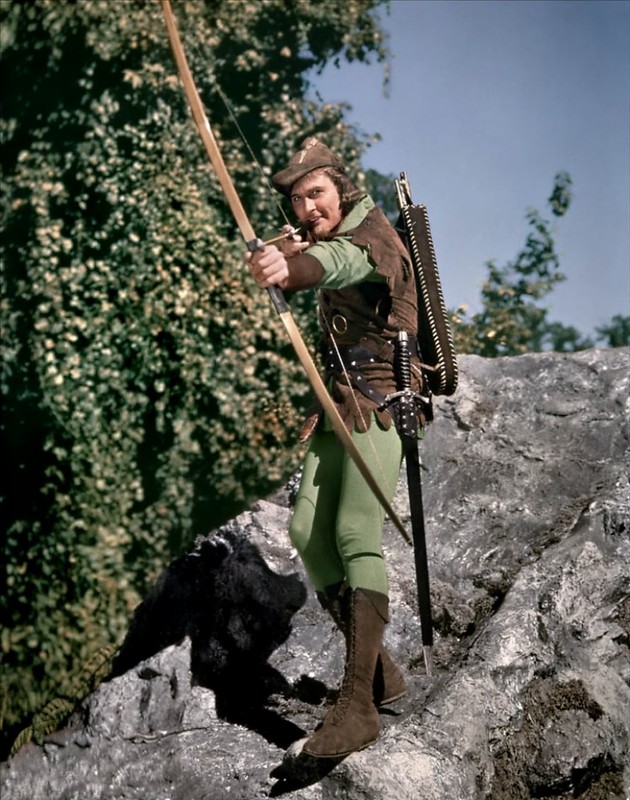
The Original Harrison Ford (2020): This group remembers the Harrison Ford (March 16, 1884 – December 2, 1957) of silent cinema– no relation to the better-known Ford of Indiana Jones fame. There are dozens of groups and pages devoted to the latter, but since there is nothing on the original Ford, we thought he deserved a site of his own. After all, he has a star on the Hollywood Walk of Fame for a reason. I first discovered Harrison Edward Ford when I watched Shadows (1922) with Lon Chaney, Sr. One thing stands out when you examine Ford’s filmography: he may not have appeared in the biggest-grossing films of all time, but he worked with some of the biggest stars.
The Sound of Hollywood: The Great Film Composers (2020): A musical history of the great Hollywood composers, including Max Steiner, Erich Wolfgang Korngold, Franz Waxman, Miklos Rozsa, Dimitri Tiomkin, Bernard Herrmann, Alfred Newman, Elmer Bernstein, Henry Mancini, and many more. The emphasis will be on the film scores of the 1930s, 1940s, and 1950s.
The Lost Worlds of Willis O’Brien (2020): An appreciation society for one of the singular talents of 20th century cinema. He was the pioneer in the art of stop-motion animation in the movies. For a legion of fans, Willis H. O’Brien (March 2, 1886 – November 8, 1962) remains one of greatest special effects artists of all time. During the making of his finest achievement, 1933’s King Kong, “Obie” was recognized as a true wizard on the studio lot. In-depth and exhaustive, this group will concentrate on all aspects of O’Brien’s life and career. It will be a detailed examination of his work, including rare material not easily accessible. This group was born out of my own admiration for his work.
Willis O’Brien at work on The Lost World (1925).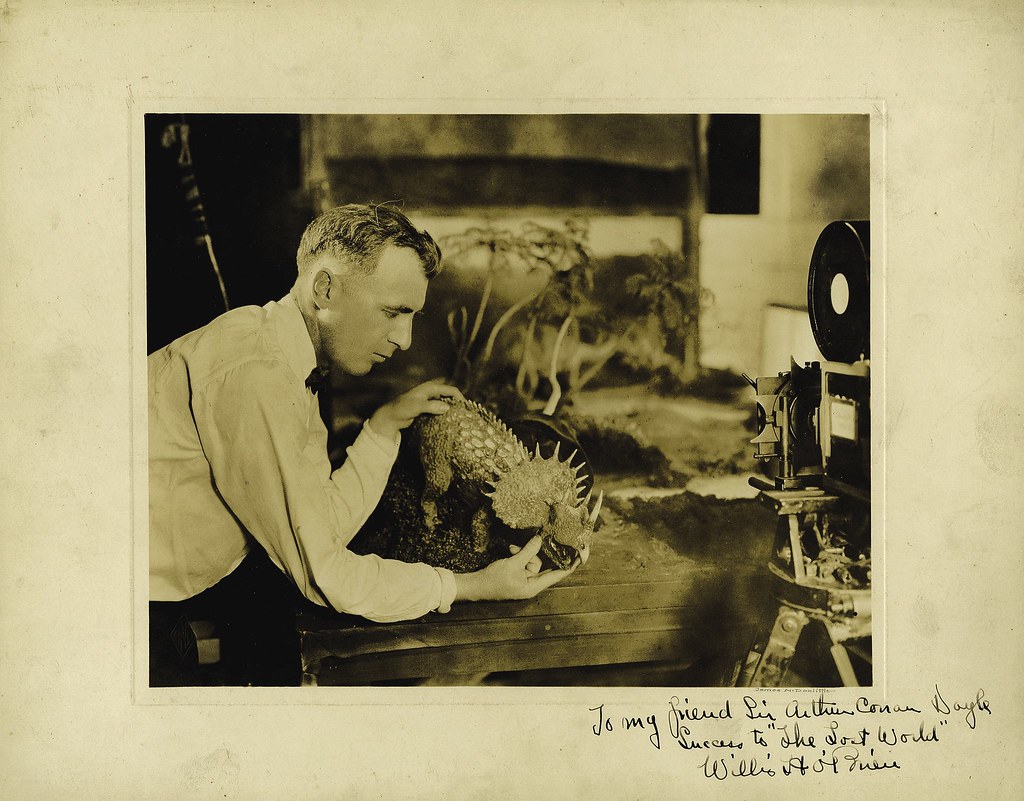
Valerie Hobson (2020): In remembrance of “the Baroness,” actress Valerie Hobson (April 14, 1917 – November 13, 1998). Best known to classic horror fans as Elizabeth in 1935’s Bride of Frankenstein, the Irish-born Hobson was an actress of great distinction, class and beauty. She became one of the leading ladies of British cinema. In addition to her American films, in particular those she made at Universal, Hobson worked with such noted English filmmakers as Michael Powell (The Spy in Black, Contraband), David Lean (Great Expectations), and Robert Hamer (Kind Hearts and Coronets).
Claudette Colbert: A Perfect Star (2020): A page dedicated to actress Claudette Colbert (Sept. 13, 1903 – July 30, 1996), the queen of the Golden Age– and the perfect star. Born Émilie Claudette Chauchoin in Paris, France, Colbert became one of the legendary stars of stage and screen with over 60 films to her credit. It was director Cecil B. DeMille who made her a star in such films as The Sign of the Cross (1932) and Cleopatra (1934). A Hollywood icon remembered for her distinct beauty, glamor, and sophistication, Claudette Colbert is probably best-known today for her Oscar-winning performance as the runaway heiress in Frank Capra’s romantic comedy It Happened One Night (1934). She excelled in all genres, but was particularly effective as a comedienne in classics like Midnight (1939) and The Egg and I (1947).
Superman ’78 (2020): The only fan group dedicated exclusively to the original Superman: The Movie (1978). All content and discussion will focus primarily with the theatrical version, the special edition, and the extended, television version of this motion picture. Directed by Richard Donner, Superman was the first modern superhero movie and the first film that I remember seeing in a theatre. Beyond the nostalgia that my generation has for this film, it remains, in my opinion, the greatest superhero movie of them all. Today, we are inundated with countless movies from the Marvel and DC universe, but Superman stands apart. With its powerful, old-fashioned storytelling, the filmmakers spared no expense in treating the character with respect. It’s a true epic that continues to influence and inspire. And over forty years later, no one has equaled Christopher Reeve’s interpretation of Superman. When we think of the character, most of us think of Reeve (with John Williams’ inseparable theme music, of course). Along with George Reeves of the 1950s TV series, Reeve is one of the great pillars of the Superman tradition and legacy.
The Shadow’s Sanctum (2021): A pulp hero group focusing exclusively on The Shadow sensation from the early 1930s until the mid-1990s. The Shadow’s Sanctum is home to all agents, a place where we can celebrate the origins and legacy of The Shadow. The content, featuring rare material, has been organized into accessible albums. Most of what will be posted is based on the pulps, the radio program, and the movies. We are less concerned with contemporary artwork, cosplay photos, or fan-made movies. (There are other groups for that.) Instead of being bogged down by 21st century re-imaginings or reinterpretations, this group will return to the origins of the character and reopen the annals of The Shadow. This group is for fans of Walter B. Gibson– not James Patterson (and his 2021 take on the character). Our intent is to dig deeper and roam darker alleyways to uncover biographical information on Gibson and his process; to further examine and appreciate the popular radio series; and to revisit the movies, especially the underrated 1994 film starring Alec Baldwin as Lamont Cranston/The Shadow.
The Spider’s Web (2021): From May 1933 to December 1943, he existed in a criminal netherworld whose villains were the personification of Evil and Death. The Spider, the masked hero who combated these dark forces, was one of the most fearsome vigilantes in the history of the pulps. Saving the world one dime at a time, he battled crime on a cosmic scale. The Spider (in reality, Richard Wentworth) was certainly one of the most intense figures in pulp lit with the majority of his 118 adventures feverishly written by Norvell W. Page. Page’s brilliantly outrageous tales, filled with anguish and sacrifice, are some of the finest stories ever told in pulpdom. The “hero pulps” would give rise to the superheroes of a later generation. Additionally, readers can see the origins of the hard-boiled tradition.The Spider’s Web will chronicle the complete history of the character with particular emphasis on the Page novels as well as on the two Columbia movie serials: The Spider’s Web (1938)– considered one of the greatest serials ever made– and The Spider Returns (1941). This group is dedicated to Norvell Page.
Batman ’43 (2021): The only group on the classic Batman serial! The Batman (1943) was the first screen realization of the “Dark Knight” and the first of two serials that Columbia Pictures produced during the 1940s– the other being 1949’s inferior Batman and Robin. Lewis Wilson, father of James Bond producer Michael G. Wilson, played the Caped Crusader in this early incarnation. Despite being in a somewhat ill-fitting costume– baggy with bat ears that look like devils horns– the suit is superior in concept to the muscle-carved body armor of modern versions. It certainly looks closer to what the comic book artists originally had in mind. In this 15-chapter serial, Batman and Robin (Douglas Croft) battle Dr. Daka (J. Carrol Naish), a Japanese mastermind of wartime espionage. Daka has an arsenal of weapons including a radium-powered death ray gun, an alligator pit for unsuspecting enemies, and the ability to electronically transform people into zombies!
Vivien Leigh: A Lass Unparalleled (2021): As Scarlett O’Hara and Blanche DuBois, Vivien Leigh (November 5, 1913 – July 8, 1967) took on two of the most challenging female roles of the 20th century. She would win Oscars for both. Gone with the Wind (1939) and A Streetcar Named Desire (1951) stand as the two great pillars of her film career. This site honors the life and career of the legendary British actress, born Vivian Mary Hartley in Darjeeling, India. “A lass unparalleled”– taken from Shakespeare’s “Antony and Cleopatra”– is a well-organized and maintained tribute designed to offer relevant and sometimes rare content– not excessive GIFs and emojis that take up space. (There are larger groups out there for that, which cater to the more obsessive fans from around the world.) But this site is built around genuine respect, understanding, and appreciation for “Lady Olivier”– ranked the 16th greatest movie star by the American Film Institute.
The 2022 Groups: The Final Dozen
The Drama of Lila Lee (2022): She is one of the more distant stars in the Hollywood firmament, but one that shined brightest during the Jazz Age. Lila Lee (July 25, 1905 – November 13, 1973) was a popular star, first as a child actor– gaining the nickname “Cuddles” from a kiddie review in which she appeared– and then as a “flapper” in the 1920s. Lila is probably best known for appearing opposite Rudolph Valentino in Blood and Sand (1922) and with the great Lon Chaney in the 1930 remake of The Unholy Three— a film that even now remains elusive to most movie buffs. Hers was a life of fame, comebacks, and misfortune. Lila’s personal life was filled with abuse, tragedy, and scandal– all of which contributed to her ultimate decline… To keep her star from being totally extinguished by the passage of time, we hope to preserve her memory within this little spot of cyberspace. As many of her films are either lost or forgotten, this group will be about discovery– and remembrance of everything she has left behind.
Dial M For Milland: The Ray Milland Film Archive (2022): For an actor who appeared in numerous classic films, Ray Milland (January 3, 1907 – March 10, 1986) is generally overlooked these days. He never made the cultural impact that a Cary Grant or a James Stewart made– both contemporaries of his– but Milland carved out his own unique niche in film history. (Not many Oscar winners can say they starred in a film like 1972’s The Thing With Two Heads.) In his heyday, he was always the solid, sometimes stellar actor (depending on the material) who brought class and sophistication to his roles. He achieved his artistic height in Billy Wilder’s The Lost Weekend (1945), playing an alcoholic writer. (This was the first time he really had to “act” in a dramatic role—and he won an Oscar for it. He was the first Welsh actor to win an Academy Award.) In the early stage of his career, Milland had often been cast in light comedies and romantic dramas, but he became, partly by chance, a leading man at Paramount and ultimately, their highest-paid star. He worked with some of the biggest actresses in Hollywood– names like Claudette Colbert, Jean Arthur, Ginger Rogers, Paulette Goddard, Marlene Dietrich, and many others. Aside from romantic comedy, he appeared in several memorable film noirs, including Fritz Lang’s Ministry of Fear (1944), John Farrow’s The Big Clock (1948) and Alias Nick Beal (1949). Other career highlights include The Uninvited (1944)—a ghost story that treated the subject matter seriously– Jacques Tourneur’s Circle of Danger (1951), The Thief (1952) and Alfred Hitchcock’s Dial M For Murder (1954).
Betty Bronson, The Eternal Pan (2022): A loving tribute to the screen’s first Peter Pan, Betty Bronson (November 17, 1906 – October 19, 1971). Elizabeth Ada Bronson started her film career in 1922, but appeared only in supporting roles. Her career took off when she was selected by Sir James Barrie to play the title role in the first film version of his play, Peter Pan (1924). She was given top billing in a number of films, including Are Parents People? (1925), The Cat’s Pajamas (1926), and A Kiss For Cinderella (1926). When the silent version of Ben-Hur (1925) was filmed, she appeared in a cameo role. Bronson made the transition to sound motion pictures and was featured in The Singing Fool (1928) and The Medicine Man (1930). Paramount hoped to build her up as a successor to Mary Pickford, but changing public tastes forced her into more mature roles which diminished her popularity. She retired in 1932 to start a family but returned in 1937 to appear in the Gene Autry western Yodelin’ Kid from Pine Ridge (1937). She made several stage appearances at the Pasadena Playhouse and Lobero Theatre in Santa Barbara. In the 1960s, she re-emerged as a character actress and appeared in television shows such as “Dr. Kildare,” “My Three Sons,” and “Run for Your Life.” and films including Blackbeard’s Ghost (1968) and Evel Knievel (1971)
Henry! Henry Aldrich! (2022): A nostalgic group for those who remember the eleven “B” movies that Paramount released in the “Henry Aldrich” series, most of which starred Jimmy Lydon: What a Life (1939), Life with Henry (1941), Henry Aldrich for President (1941), Henry Aldrich, Editor (1942), Henry and Dizzy (1942), Henry Aldrich Swings It (1943), Henry Aldrich Gets Glamour (1943), Henry Aldrich Haunts a House (1943), Henry Aldrich, Boy Scout (1944), Henry Aldrich Plays Cupid (1944), and Henry Aldrich’s Little Secret (1944). It was a different time. A different place. A different attitude. We don’t expect today’s generation to relate. I see no Henry Aldrich film revival forthcoming. But for some of us– yes, even some under the age of 50!– we grew up watching these films on local television, and they were simply fun. Personally, I was always drawn more to the Henry Aldrich series than I was to the Andy Hardy films with Mickey Rooney. Jimmy Lydon seemed more relatable to me than the often-mugging Rooney. (The series was, in fact, Paramount’s answer to MGM’s Andy Hardy.) I have fond memories from my childhood of watching films like Henry Aldrich Haunts a House or Henry Aldrich, Editor. I hope there are other fans out there…
Mr. Moto: The Complete History (2022): A celebration and documentation of Mr. Moto, a character first made famous in the “Saturday Evening Post” stories by author John P. Marquand. However, Mr. Moto is best remembered for the eight films he appeared in made by 20th Century Fox and starring Peter Lorre. Mr. Moto was the Japanese equivalent of the Chinese Charlie Chan. However, whereas Charlie was strictly a detective, Moto’s background was more mysterious. He dabbled in detective work as a hobby, but he was also a spy– and an expert in judo– making him more of a physical presence than his Chinese counterpart. Unassuming in nature and exceedingly well-mannered, Moto was a force to be reckoned with while on his mission. Peter Lorre brought the character to life and projected intelligence, humor, and sensitivity into the portrayal. Though Lorre was Hungarian, he was an actor playing a role; he was not portraying an offensive stereotype. Although some Asian-American actors did make a name for themselves as character actors at this time (such as Keye Luke), the reality is that in the late 1930s, audiences paid to see known stars, whether it was Peter Lorre, Boris Karloff or Warner Oland. The Mr. Moto films were a solid series of B mysteries, some better than others and a few quite good. Lorre’s performances throughout reveal what a brilliant actor he was, and rare was it that he had the opportunity to play the hero on film. This group will focus on the six Marquand novels and the eight films with Lorre: Think Fast, Mr. Moto (1937), Thank You, Mr. Moto (1937), Mr. Moto’s Gamble (1938), Mr. Moto Takes a Chance (1938), Mysterious Mr. Moto (1938), Mr. Moto’s Last Warning (1939), Mr. Moto in Danger Island (1939), and Mr. Moto Takes a Vacation (1939).
Howard Hawks: The Man and His Films (2022): Howard Hawks (May 30, 1896 – December 26, 1977) was a master storyteller who excelled in every film genre– from gangster films (Scarface) to screwball comedies (Bringing Up Baby) to Westerns (Rio Bravo). His only Academy Award nomination, however, was for the memorable Sergeant York. Hawks’ films are no-nonsense and unsentimental. Viewed today, they seem fresh and true to life with his penchant for on-the-set improvisation. He directed over 40 films and the majority of them are classics.
The Lubitsch Touch (2022): A look at the life and legacy of director Ernst Lubitsch (January 29, 1892 – November 30, 1947). Some of his finest works include Trouble in Paradise (1932), The Merry Widow (1934), Ninotchka (1939), and To Be or Not to Be (1942).
The Westerns of Errol Flynn (2022): Errol Flynn (June 20, 1909 – October 14, 1959) is best remembered as the swashbuckling hero of such adventure classics as Captain Blood (1935), The Adventures of Robin Hood (1938), and The Sea Hawk (1940). The second-most popular genre in which he starred was that of the Western. Unlike other movie groups that celebrate the totality of Flynn’s career, this one will be concerned exclusively with the eight Westerns he appeared in. A special emphasis will be placed on his first, Dodge City (1939), which ranks as one of the finest Westerns Hollywood ever produced during its golden age.
Directed by Raoul Walsh (2022): If White Heat (1949) had been his only credit, Raoul Walsh would be remembered today as a dynamic filmmaker. But add to that countless other classics and you have one of the legendary filmmakers from Hollywood’s Golden Age. Raoul Walsh (March 11, 1887 – December 31, 1980) has over a hundred directorial credits to his name, including silent film classics like Regeneration (1915), The Thief of Bagdad (1924) with Douglas Fairbanks, and What Price Glory (1926)–his most successful silent. However, Walsh is best known for the films he made at Warner Brothers as a contract director, reaching his zenith in the 1940s. He directed gangster films like The Roaring Twenties (1939), High Sierra (1941), and White Heat (1949)– the latter two representing two stages in the development of film noir. During the 1940s, he made other noirs, including The Man I Love (1947) and Pursued (1947). Walsh’s films were a call to action, and he was one of the finest action directors in the business. He directed many of Errol Flynn’s best films, including They Died With Their Boots On (1941), Gentleman Jim (1942), and Objective, Burma! (1945)– the latter being one of the most noteworthy war films of the period. Walsh also directed many Westerns, including The Big Trail (1930) with John Wayne and Colorado Territory (1949)—a Western remake of High Sierra. Throughout his career, Walsh worked with some of the biggest stars in the industry. His final film was in 1964.
The Clockwork Wizards: A Dr. Phibes Appreciation Society (2022): Dr. Phibes is back in this new group honoring the 50+ year history of The Abominable Dr. Phibes (1971) and Dr. Phibes Rises Again (1972). The “Clockwork Wizards”– a collection of Phibes followers– will chronicle the complete history of Phibes and its enduring legacy. We will also celebrate the man behind the mask and at the center of it all, Vincent Price. In these films, Price plays the disfigured Anton Phibes– a scientist/organist who is unrelenting in his pursuit of revenge against those who wronged him. He is equally passionate in his undying love for his dead wife. Throughout the series, Phibes is assisted by the silent and mysterious Vulnavia. The films are both darkly comic and strangely poignant. The only thing our group is promoting– aside from Justin Humphreys’ The Dr. Phibes Companion— is an appreciation for the artistry of these two films, both of which were directed by Robert Fuest. Besides Price’s performances in them, the films are remembered for their stylish art direction and bizarre (and very British) humor. Within the confines of this group we will profile the cast and crew of both productions and share photos and information not readily available on other Facebook sites.
